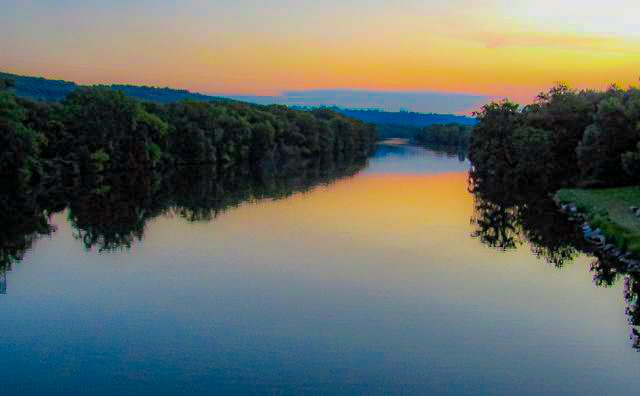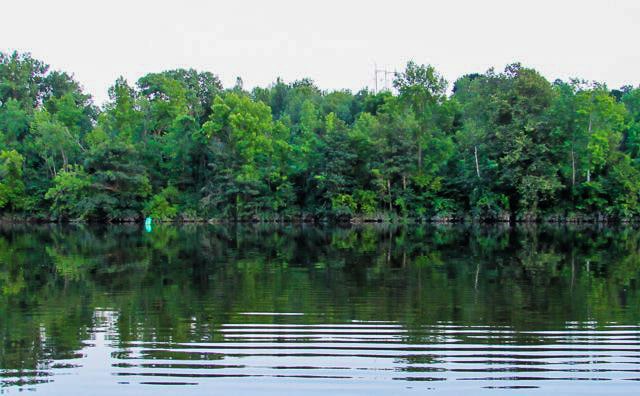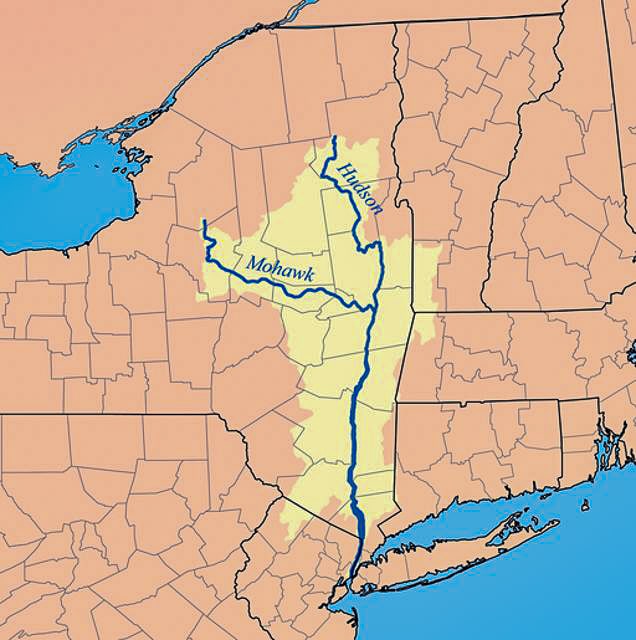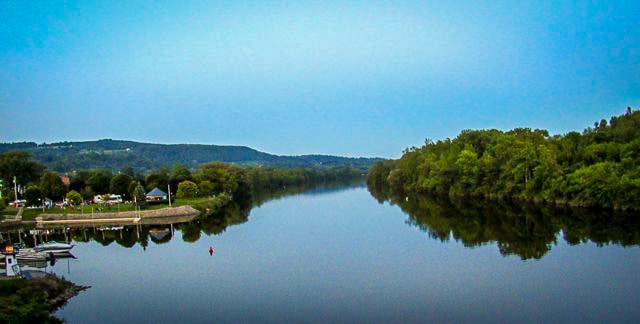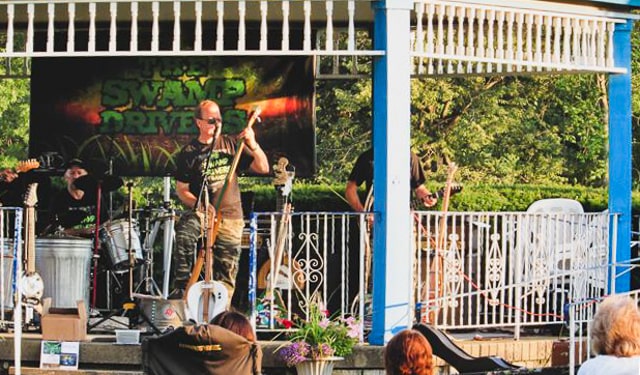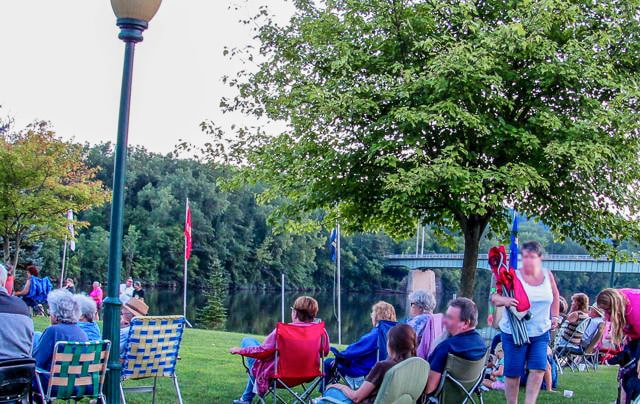The Mohawk River is in Central New York and is the largest tributary of the Hudson River.
Rivers are sometimes taken for granted. Stop and think – you see one, enjoy the natural beauty, and perhaps admire a yacht sailing along on this waterway. But have you ever spent time learning about a river that is of interest to you? I grew up in a part of New York State that is steeped in natural beauty and history. A bit over 100-yards from my childhood home the Mohawk River flows.
It was always just there, flowing majestically by, where I had to walk or bike over the bridge to get to town. Sure, it was interesting to stand on the bridge and look down, watch the boats go by under you. Maybe drop a pebble or stone from high on the bridge to watch the ripples it would produce. But again, it was always just there. One blessing of age is that you tend to reevaluate what you missed when you were younger, learning to admire it more and acknowledge how it may have shaped your view as you mature. So, let me tell you about my Mohawk River.
History
The Mohawk River is in Central New York and is the largest tributary of the Hudson River. It forms in Oneida County, at the juncture of the West Branch and East Branch and continues to flow south and east to join the Hudson some 149-miles later. The Mohawk connects the Hudson and the port of New York to the Great Lakes at Buffalo. The Schoharie Creek and West Canada are the main tributaries of the Mohawk.
Approximately 78% of the Erie Canal parallels the river from Rome to its union with the Hudson. Most of this section of the Canal has been abandoned and replaced by the river. The river’s channel has been deepened and straightened through the years.
The river flows past and through several central New York cities such as Rome, Utica, Amsterdam, and Schenectady. In between the cities of Utica and Amsterdam lies the small town of St. Johnsville. I grew up in this town with the river practically in my front yard.
The river was named for the Mohawk Nation, one of the Five Nations of the Iroquois Confederacy. During the 1700s and prior, the Mohawk people were based here. Their territory ranged north to the St. Lawrence River, southern Quebec, and eastern Ontario, south to New Jersey, east to Vermont, and west to Oneida Nation territory. This was a major waterway for the Mohawk people. They called it Tenonanstche, or “a river flowing through a mountain.”
The first recorded European exploration of the river was by a Dutchman in 1634, who sailed upstream from Albany into Mohawk Territory. After that point, many Dutch and German Palatines also made their way up the Mohawk to form various settlements. Their influence in the local area became staggering and long-lasting, as evidenced by many other historical places in the Mohawk Valley. The river also helped shape other transportation routes. The railroad runs alongside the river as well as the paved thoroughfares of Route 5 and Interstate 90.
Personal reflection
Now, let me tell you about growing up near the river. As a kid, you learn the facts and history surrounding the river. This information is wonderful, but in reality, I recall walking along the towpath, imagining the animals that may have pulled a boat up the river before they became motorized. I might find an arrowhead that reminded me of when the Mohawk people lived, fought, and died in the area. I would see turtles taking a stroll across the path. I would see an array of different birds overhead in the trees or other little critters in the brush alongside the path. I remember walking down beside the bridge to sit on the huge concrete pillars and walls here for some alone thinking time.
From the front porch of my childhood home, I could hear the barges as they chugged on by. Taking a short walk down to the river bridge gives one a striking view.
I watched the boats and saw fabulous yachts sail under me, their occupants soaking up the sun as they waved and drifted on by.
There is also a marina, where the yachts mentioned above can pull up and stay awhile. Sometimes, if you were at the marina when they arrived, you might be lucky enough to get a quick tour of their vessel if they were so inclined. But undoubtedly, you always got to meet and talk to people who were not from the area. If you were a canoe or kayak enthusiast, you could launch from the marina. You could enjoy a secluded area along the towpath if you were a local and knew the best spots. In my youth, I took it for granted, as it was always ‘just there.’
As happens in one’s normal course of life, I moved away from my hometown. I would still visit, as much of my family remained there. However, it was not until recent years that I returned with a different viewpoint. One of appreciation and wonder for all that I may have missed.
Things have changed as they normally do as time progresses. The towpath has mostly been forgotten but in its place is a wonderful bike and walking path. It is a great place to walk, either alone or in the company of family and pets. As much of it has been paved, it is perfect for a bike ride. Whether you are walking, biking, or jogging, chances are you will pass by someone from town that you know or a visitor enjoying the area’s beauty.
The marina has added RV and camper parking, either for a night or two or for the summer season.
During the summer, weather permitting, the village sponsors weekly concerts at the Marina, which brings an added sense of community and hospitality. The boats sailing along the river pull in to listen, the campers step out of their RV’s, and the community brings their lawn chairs.
All gather around and enjoy each other for a couple of hours on a weekday evening while sun sets in the background and the river sits beside you and listens.
Even though I did move on from that quaint village and its surroundings, I will always remember my time growing up near the Mohawk River. I can now appreciate all its nuances and wonder at the history it holds. The river knows all and sees all. It only asks for respect and appreciation in return.

About Lisa Evans—Lisa is a freelance travel writer and photographer. She has always enjoyed the outdoors and nature and often includes them in her writing and photography. History is another passion – every place has a story to tell if only you find it. Exploring different areas can uncover a myriad of information to share with the world. She enjoys writing about her local area, sharing what she knows so other people can appreciate it as well. She also knows many other places to seek out and discover. Lisa plans to continue to write about and photograph as many as possible. Lisa is a member of TravMedia and Travel Writer’s Cafe and has written for various publications. She maintains a website, Writer Lisa. See more work on Facebook and Instagram.

